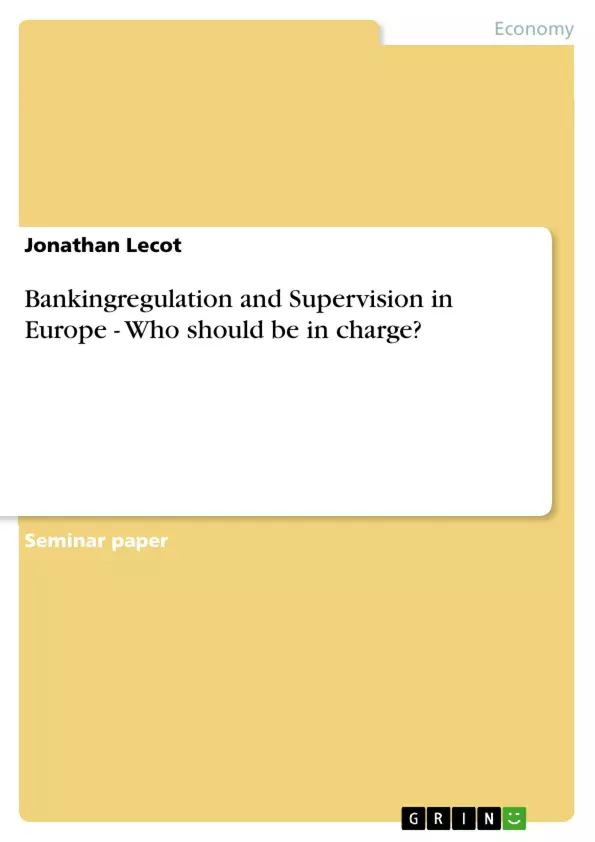When the bank crisis finally reached its peak in the United States in mid September 2008, not only was the USA involved in this crisis but Europe also. Many of the European governments have had to intervene with the tax payers’ money in order to avoid a bank failure. How did these negative cross-border effects come about?
The massive deregulation of the banking system during the last 20 years led to an extreme enlargement of the banking system (Dermine, 2005) and large-scale cross-border mergers have become a trend. (Gulde/ Wolf, 2005). Also, due to the process of globalization, integration of the banking system has become more and more important. Therefore, correct banking regulation and supervision is all the more relevant.
There are three main components of a bank regulatory arrangement: deposit insurance, supervision and Lender of Last Resort. In Europe, an approach of partial harmonization has been adopted, based on three main principles: harmonization of minimum standards, home-country control and mutual recognition. (Kahn and Santos, 2002, 4). Therefore, financial supervision in Europe remains very fragmented, at a country level. Any explicit reference regarding the assignment of European responsibilites, “who takes care of financial stability in Europe”, is still absent. (Die Giorgio, Di Noia, 2001,4).
Inhaltsverzeichnis (Table of Contents)
- I. Introduction
- II. National Regulation and Supervision
- II.1 Consideration of the current system
- II.2 Home Country regulation, more and more insufficient
- II.3 More Host Country control?
- II.4 Disadvantages of the Host country approach
- II. 5 Discussion of national regulation
- III. Supervision and regulation on the European level
- III.1 Discussion of European regulation
- III. 2 Separation of Monetary Policy and Bank Supervision
- III. 3 Combination of Monetary Policy and Bank Supervision
- III. 4 Discussion of bank regulation and supervision: separation or combination
- IV The European solution
Zielsetzung und Themenschwerpunkte (Objectives and Key Themes)
This paper aims to examine the role of European banking regulation and supervision, specifically focusing on who should be in charge. It will explore the advantages and disadvantages of the current system, focusing particularly on bank supervision. The paper will argue for a European entity responsible for regulation and supervision, especially in light of the 2008 crisis. Additionally, it will consider whether monetary policy and banking supervision should be combined or kept separate, advocating for a combined system to ensure systemic stability.
- European Banking Regulation and Supervision
- National vs. European Regulation and Supervision
- The Role of the European Central Bank
- The Impact of the 2008 Financial Crisis
- Separation or Combination of Monetary Policy and Banking Supervision
Zusammenfassung der Kapitel (Chapter Summaries)
- I. Introduction: This chapter introduces the topic of banking regulation and supervision in Europe, highlighting the impact of the 2008 financial crisis and the need for a strong regulatory framework in the context of increasing globalization and cross-border banking activities. It outlines the three main components of a bank regulatory arrangement: deposit insurance, supervision, and lender of last resort. It also highlights the current system in Europe, based on partial harmonization and home-country control, and its limitations in addressing cross-border spillover effects.
- II. National Regulation and Supervision: This chapter delves into the existing national regulatory framework in Europe, examining the current system and its drawbacks. It discusses the implications of home-country control, particularly the challenges posed by multinational banks and cross-border spillover effects. The chapter also explores the potential benefits and drawbacks of increasing host-country control and discusses the need for improved information sharing between regulators.
- III. Supervision and Regulation on the European Level: This chapter examines the potential for European-level supervision and regulation, considering different approaches. It discusses the separation of monetary policy and bank supervision, as well as the potential benefits and drawbacks of combining these functions. This chapter will explore the arguments for and against a centralized European entity for banking regulation and supervision.
Schlüsselwörter (Keywords)
The key topics and concepts explored in this paper include European banking regulation, supervision, national regulation, home-country control, host-country control, cross-border spillover effects, the European Central Bank, monetary policy, banking supervision, systemic stability, and the 2008 financial crisis.
- Quote paper
- Dipl. Jonathan Lecot (Author), 2009, Bankingregulation and Supervision in Europe - Who should be in charge?, Munich, GRIN Verlag, https://www.grin.com/document/153728



